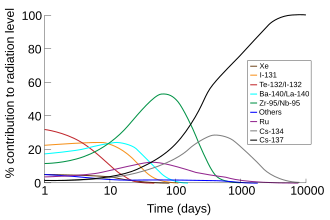Isotopes of iodine
Isotopes of Iodine refer to the different atomic forms of the chemical element iodine. Each isotope of iodine contains 53 protons in its nucleus but differs in the number of neutrons. Iodine's atomic number is 53, and its chemical symbol is I. The isotopes of iodine range from having very few neutrons to having many more than the stable isotopes. Among these, only one is stable: Iodine-127 (127I), which is also the only naturally occurring isotope of iodine.
Stable and Radioactive Isotopes
The most significant isotope of iodine for biological systems and medical applications is 127I, due to its stability and natural abundance. However, several radioactive isotopes of iodine have critical applications in medicine and industry, notably 123I, 124I, 125I, and 131I.
Radioactive Isotopes
- 123I is used in nuclear medicine for imaging and diagnostic purposes, particularly in thyroid scans.
- 124I is used in Positron Emission Tomography (PET) scans, offering detailed images for diagnostic purposes.
- 125I is used in radiotherapy for treating certain types of cancer, as well as in various laboratory assays.
- 131I is well-known for its use in treating thyroid cancer and hyperthyroidism, as it concentrates in the thyroid gland and destroys thyroid tissue with its beta emissions.
Decay and Half-Life
Each radioactive isotope of iodine has a specific half-life, the time it takes for half of the isotope to decay. For example, 131I has a half-life of about 8 days, making it suitable for medical treatments as it decays relatively quickly, minimizing radiation exposure to the patient.
Production
Radioactive isotopes of iodine are typically produced in nuclear reactors or cyclotrons by bombarding a target, usually made of xenon or tellurium, with neutrons or protons.
Applications
Beyond medical applications, isotopes of iodine have uses in environmental science, such as tracking animal migration and studying ocean circulation patterns through the analysis of iodine isotopes in soil and water samples.
Safety and Environmental Concerns
While isotopes like 131I are invaluable in medicine, they also pose safety and environmental concerns. For instance, 131I released into the environment as a result of nuclear accidents or tests can be absorbed by the thyroid gland, potentially causing thyroid cancer. Therefore, handling and disposal of iodine isotopes, especially the radioactive ones, require strict safety protocols to protect both human health and the environment.
Transform your life with W8MD's budget GLP-1 injections from $125.
W8MD offers a medical weight loss program to lose weight in Philadelphia. Our physician-supervised medical weight loss provides:
- Most insurances accepted or discounted self-pay rates. We will obtain insurance prior authorizations if needed.
- Generic GLP1 weight loss injections from $125 for the starting dose.
- Also offer prescription weight loss medications including Phentermine, Qsymia, Diethylpropion, Contrave etc.
NYC weight loss doctor appointments
Start your NYC weight loss journey today at our NYC medical weight loss and Philadelphia medical weight loss clinics.
- Call 718-946-5500 to lose weight in NYC or for medical weight loss in Philadelphia 215-676-2334.
- Tags:NYC medical weight loss, Philadelphia lose weight Zepbound NYC, Budget GLP1 weight loss injections, Wegovy Philadelphia, Wegovy NYC, Philadelphia medical weight loss, Brookly weight loss and Wegovy NYC
|
WikiMD's Wellness Encyclopedia |
| Let Food Be Thy Medicine Medicine Thy Food - Hippocrates |
Medical Disclaimer: WikiMD is not a substitute for professional medical advice. The information on WikiMD is provided as an information resource only, may be incorrect, outdated or misleading, and is not to be used or relied on for any diagnostic or treatment purposes. Please consult your health care provider before making any healthcare decisions or for guidance about a specific medical condition. WikiMD expressly disclaims responsibility, and shall have no liability, for any damages, loss, injury, or liability whatsoever suffered as a result of your reliance on the information contained in this site. By visiting this site you agree to the foregoing terms and conditions, which may from time to time be changed or supplemented by WikiMD. If you do not agree to the foregoing terms and conditions, you should not enter or use this site. See full disclaimer.
Credits:Most images are courtesy of Wikimedia commons, and templates, categories Wikipedia, licensed under CC BY SA or similar.
Contributors: Prab R. Tumpati, MD


